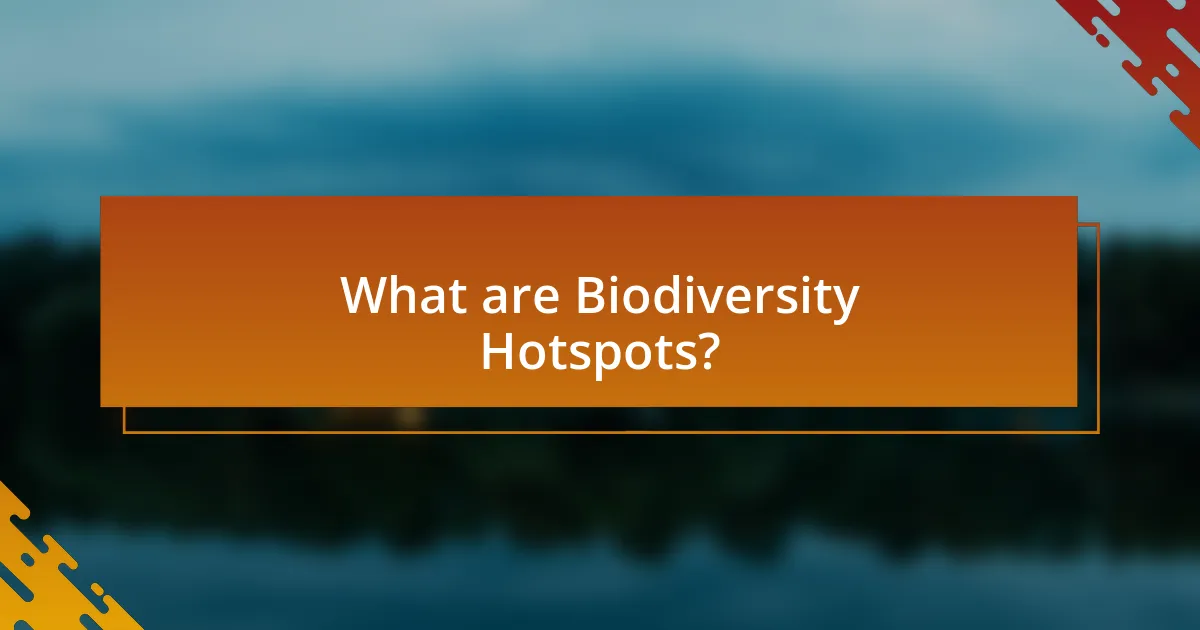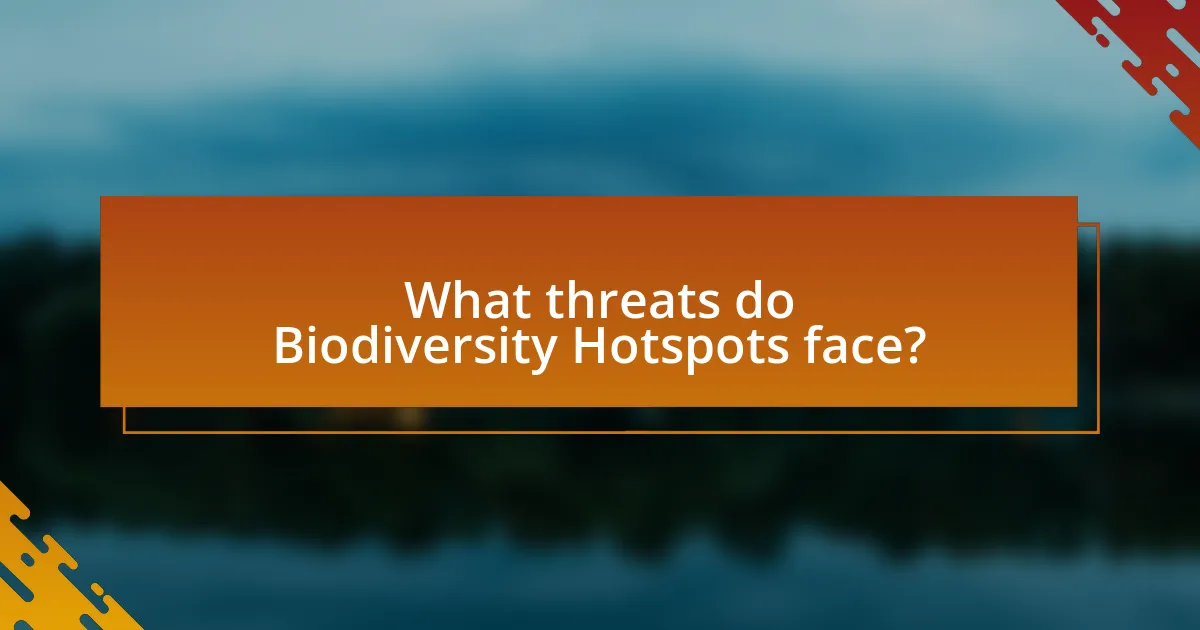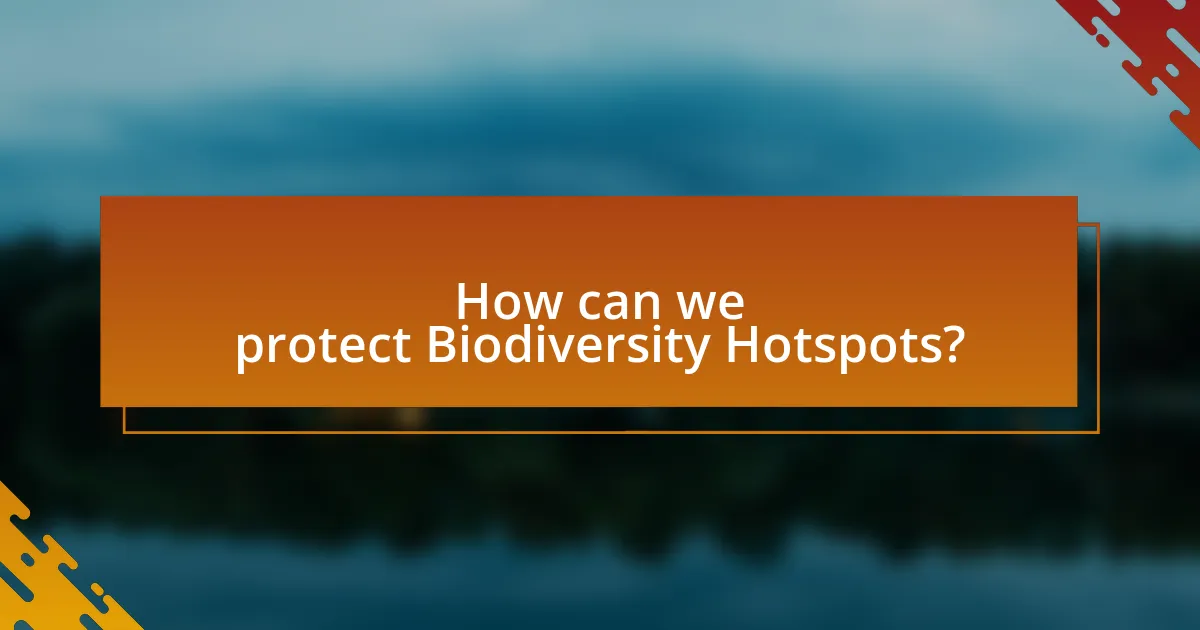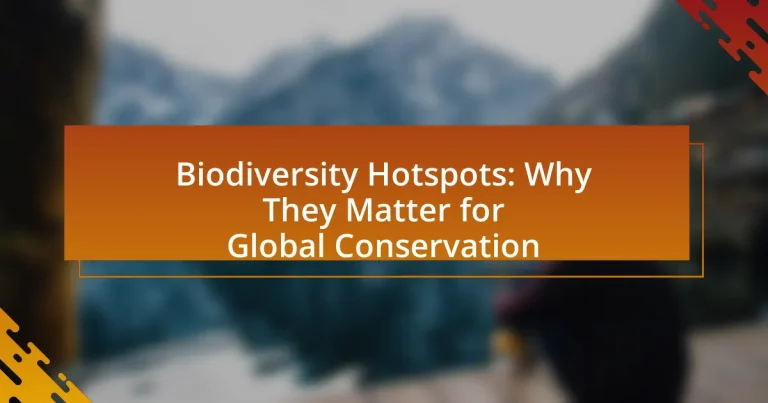Biodiversity hotspots are regions characterized by high levels of endemic species that are significantly threatened by human activities. To qualify as a biodiversity hotspot, an area must contain at least 1,500 species of vascular plants as endemics and have lost at least 70% of its original habitat. This article outlines the criteria for identifying biodiversity hotspots, their importance for global conservation, and the threats they face, including habitat loss and climate change. It also discusses effective conservation strategies, the role of local communities, and the implications of losing these critical ecosystems for both biodiversity and human populations.

What are Biodiversity Hotspots?
Biodiversity hotspots are regions that are both rich in endemic species and significantly threatened by human activities. To qualify as a biodiversity hotspot, a region must contain at least 1,500 species of vascular plants as endemics and have lost at least 70% of its original habitat. These areas are crucial for global conservation efforts because they represent a small percentage of Earth’s land surface yet hold a large proportion of its biodiversity. For instance, the Tropical Andes and the Western Ghats are recognized as biodiversity hotspots due to their unique flora and fauna, which are under severe threat from deforestation and urbanization.
How are Biodiversity Hotspots defined?
Biodiversity Hotspots are defined as regions that are both rich in endemic species and significantly threatened by human activities. Specifically, a region must contain at least 1,500 species of vascular plants as endemics and must have lost at least 70% of its original habitat to qualify as a Biodiversity Hotspot. This definition is supported by the criteria established by Norman Myers in 1988, which has been widely adopted in conservation biology to prioritize areas for conservation efforts.
What criteria are used to identify Biodiversity Hotspots?
Biodiversity hotspots are identified based on two main criteria: they must contain at least 1,500 species of vascular plants as endemics, and they must have lost at least 70% of their original habitat. The first criterion ensures that the area has a significant level of plant diversity that is unique to that region, while the second criterion highlights the urgency for conservation efforts due to habitat loss. These criteria were established by Norman Myers in 1988 and have been widely adopted in conservation biology to prioritize areas for protection and restoration.
Why is the concept of Biodiversity Hotspots important?
The concept of Biodiversity Hotspots is important because it identifies regions that are both rich in endemic species and significantly threatened by human activities. These areas, which cover only about 2.3% of Earth’s land surface, contain more than half of the world’s plant species as endemics and nearly 43% of bird, mammal, reptile, and amphibian species. Protecting these hotspots is crucial for global conservation efforts, as they represent critical ecosystems that provide essential services, such as carbon storage and water filtration, while also supporting biodiversity that is vital for ecological balance.
What regions are recognized as Biodiversity Hotspots?
Biodiversity Hotspots are regions that are both rich in endemic species and significantly threatened by human activities. Specifically, there are 36 recognized Biodiversity Hotspots globally, including areas such as the Amazon rainforest, the Himalayas, the Caribbean islands, and the Mediterranean Basin. These regions collectively contain a high percentage of the world’s plant and animal species, with many found nowhere else on Earth, making their conservation critical for maintaining global biodiversity.
How many Biodiversity Hotspots exist globally?
There are currently 36 recognized Biodiversity Hotspots globally. These areas are characterized by significant levels of plant endemism and are experiencing habitat loss, making them critical for conservation efforts. The concept of Biodiversity Hotspots was first proposed by Norman Myers in 1988, and the criteria for designation include having at least 1,500 species of vascular plants as endemics and losing at least 70% of its original habitat.
What are some examples of notable Biodiversity Hotspots?
Some notable Biodiversity Hotspots include the Amazon rainforest, the Himalayas, and the Caribbean Islands. The Amazon rainforest is recognized for its unparalleled diversity, housing approximately 10% of all known species on Earth. The Himalayas, known for their unique ecosystems, are home to numerous endemic species and serve as a critical water source for millions. The Caribbean Islands, with their rich marine and terrestrial biodiversity, contain many species that are not found anywhere else. These regions are crucial for global conservation efforts due to their high levels of endemism and the significant threats they face from human activities.
Why do Biodiversity Hotspots matter for global conservation?
Biodiversity hotspots matter for global conservation because they are regions that are both rich in endemic species and significantly threatened by human activities. These areas, which cover only about 2.3% of Earth’s land surface, contain more than half of the world’s plant species as endemics and nearly 43% of bird, mammal, reptile, and amphibian species. Protecting biodiversity hotspots is crucial for maintaining ecological balance, as they provide essential ecosystem services such as carbon storage, water purification, and soil fertility. Furthermore, conservation efforts in these hotspots can lead to the preservation of genetic diversity, which is vital for adapting to climate change and other environmental pressures.
How do Biodiversity Hotspots contribute to ecosystem services?
Biodiversity hotspots contribute to ecosystem services by providing critical functions such as pollination, water purification, and climate regulation. These regions, characterized by high levels of endemic species and significant habitat loss, support diverse biological communities that enhance ecosystem resilience. For instance, the Amazon rainforest, a recognized biodiversity hotspot, plays a vital role in carbon sequestration, which mitigates climate change effects. Additionally, studies indicate that areas with rich biodiversity can improve agricultural productivity through natural pest control and pollination services, thereby supporting food security.
What role do Biodiversity Hotspots play in species conservation?
Biodiversity Hotspots play a crucial role in species conservation by prioritizing areas that are both rich in endemic species and significantly threatened by habitat loss. These regions, identified by criteria such as having at least 1,500 species of vascular plants as endemics and experiencing over 70% habitat destruction, serve as focal points for conservation efforts. For instance, the Amazon rainforest, recognized as a Biodiversity Hotspot, is home to approximately 10% of all known species, making its protection vital for global biodiversity. By concentrating resources and conservation strategies in these hotspots, efforts can effectively mitigate extinction risks and preserve unique ecosystems.

What threats do Biodiversity Hotspots face?
Biodiversity Hotspots face significant threats primarily from habitat loss, climate change, invasive species, pollution, and overexploitation. Habitat loss, driven by agriculture, urbanization, and deforestation, has led to the degradation of ecosystems essential for numerous species. Climate change exacerbates these issues by altering habitats and species distributions, making it difficult for many organisms to adapt. Invasive species disrupt local ecosystems, often outcompeting native species for resources. Pollution, including chemical runoff and plastic waste, further degrades habitats and harms wildlife. Overexploitation of resources, such as overfishing and poaching, directly threatens species survival. Collectively, these threats endanger the rich biodiversity found in these critical areas, which are home to a significant proportion of Earth’s species.
How does habitat loss impact Biodiversity Hotspots?
Habitat loss significantly reduces the ecological integrity of Biodiversity Hotspots, leading to declines in species richness and endangerment of endemic species. Biodiversity Hotspots, defined as regions with high levels of endemic species that are under significant threat from human activities, are particularly vulnerable to habitat destruction caused by urbanization, agriculture, and deforestation. For instance, the Amazon rainforest, a critical Biodiversity Hotspot, has lost approximately 17% of its forest cover in the last 50 years, resulting in the extinction of numerous species and the disruption of ecological processes. This loss not only threatens the unique flora and fauna but also undermines ecosystem services that are vital for human well-being, such as carbon storage and water purification.
What are the main causes of habitat destruction in these areas?
The main causes of habitat destruction in biodiversity hotspots include deforestation, urbanization, agriculture, and climate change. Deforestation, driven by logging and land conversion for agriculture, results in significant loss of forested areas, which are crucial for many species. Urbanization leads to habitat fragmentation as cities expand, reducing the available space for wildlife. Agriculture, particularly monoculture practices, depletes natural ecosystems and disrupts local biodiversity. Climate change exacerbates these issues by altering habitats and threatening species survival. According to the World Wildlife Fund, approximately 1 million species are at risk of extinction due to these factors, highlighting the urgent need for conservation efforts in these critical areas.
How does climate change affect Biodiversity Hotspots?
Climate change negatively impacts Biodiversity Hotspots by altering ecosystems, leading to species loss and habitat degradation. These regions, which are rich in endemic species, face increased temperatures, altered precipitation patterns, and extreme weather events, all of which disrupt the delicate balance of their ecosystems. For instance, a study published in “Nature Climate Change” by Thomas et al. (2004) indicates that climate change could lead to the extinction of up to 30% of species in these hotspots if global temperatures rise by 2 degrees Celsius. This loss of biodiversity not only threatens the unique species found in these areas but also undermines the ecosystem services they provide, such as carbon storage and water purification.
What are the consequences of losing Biodiversity Hotspots?
Losing Biodiversity Hotspots leads to significant ecological and economic consequences. These areas, which are rich in endemic species and unique ecosystems, provide essential services such as carbon storage, water purification, and soil fertility. The loss of these hotspots results in decreased species diversity, which can destabilize ecosystems and reduce their resilience to environmental changes. For instance, the extinction of a single species can disrupt food webs and lead to further biodiversity loss. Additionally, the economic impact is profound; regions that rely on biodiversity for tourism, agriculture, and fisheries may experience declines in revenue and livelihoods. According to a study published in “Nature” by Myers et al. (2000), the degradation of these hotspots threatens over 50% of the world’s plant and animal species, underscoring the urgency of conservation efforts.
How does the loss of Biodiversity Hotspots affect global biodiversity?
The loss of Biodiversity Hotspots significantly diminishes global biodiversity by reducing the variety of species and ecosystems that exist on Earth. Biodiversity Hotspots, defined as regions with high levels of endemic species that are under threat from habitat loss, are crucial for maintaining ecological balance. When these areas are lost, the unique species that inhabit them face extinction, leading to a decline in genetic diversity and the disruption of ecosystem services such as pollination, water purification, and climate regulation. For instance, the destruction of the Atlantic Forest in Brazil has resulted in the extinction of numerous species, highlighting the direct correlation between habitat loss in Biodiversity Hotspots and the overall decline in global biodiversity.
What implications does this have for human populations?
Biodiversity hotspots significantly impact human populations by influencing ecosystem services essential for survival, such as clean water, food security, and climate regulation. These regions, which are rich in endemic species and face high levels of habitat loss, provide critical resources that support livelihoods and health. For instance, the loss of biodiversity in hotspots can lead to decreased agricultural productivity, as diverse ecosystems contribute to soil fertility and pest control. According to the Convention on Biological Diversity, healthy ecosystems are vital for sustaining human life, as they provide approximately 60% of the world’s ecosystem services. Therefore, the degradation of biodiversity hotspots poses a direct threat to human well-being and economic stability.

How can we protect Biodiversity Hotspots?
To protect biodiversity hotspots, it is essential to implement conservation strategies that include establishing protected areas, enforcing sustainable land-use practices, and promoting community engagement in conservation efforts. Protected areas, such as national parks and reserves, help preserve critical habitats and species, as evidenced by the fact that protected areas cover approximately 15% of the Earth’s land surface, which is crucial for maintaining biodiversity. Sustainable land-use practices, such as agroforestry and responsible tourism, reduce habitat destruction and promote ecosystem health. Furthermore, engaging local communities in conservation initiatives fosters stewardship and ensures that conservation efforts are culturally relevant and economically viable, as demonstrated by successful community-led conservation projects in regions like Madagascar.
What conservation strategies are effective for Biodiversity Hotspots?
Effective conservation strategies for Biodiversity Hotspots include habitat protection, sustainable land-use practices, and community engagement. Habitat protection involves establishing protected areas to conserve critical ecosystems, which is essential as Biodiversity Hotspots contain a significant proportion of Earth’s species. Sustainable land-use practices, such as agroforestry and ecotourism, help balance human needs with conservation goals, reducing habitat destruction. Community engagement ensures local populations are involved in conservation efforts, leading to better outcomes, as evidenced by successful initiatives in regions like Madagascar, where local stewardship has improved biodiversity outcomes.
How can local communities be involved in conservation efforts?
Local communities can be involved in conservation efforts by actively participating in the management and protection of local biodiversity. This involvement can take the form of community-led initiatives, such as establishing protected areas, engaging in sustainable land-use practices, and participating in biodiversity monitoring programs. For instance, the establishment of community conservancies in Namibia has shown that local management can lead to increased wildlife populations and improved livelihoods, demonstrating the effectiveness of local engagement in conservation. Additionally, studies indicate that when communities are empowered and included in decision-making processes, conservation outcomes are more successful, as seen in the case of the Amazon rainforest, where local stewardship has been crucial in reducing deforestation rates.
What role do governments and NGOs play in protecting these areas?
Governments and NGOs play crucial roles in protecting biodiversity hotspots through policy-making, conservation initiatives, and community engagement. Governments establish legal frameworks and regulations to safeguard these areas, often designating protected regions and enforcing environmental laws. For instance, the establishment of national parks and wildlife reserves helps preserve critical habitats. NGOs complement these efforts by conducting research, raising awareness, and mobilizing resources for conservation projects. A notable example is the work of the World Wildlife Fund, which collaborates with local communities and governments to implement sustainable practices. Together, these entities enhance conservation outcomes, as evidenced by the increase in protected areas globally, which rose from 13% in 2010 to over 15% in 2020, according to the Protected Planet Report.
What actions can individuals take to support Biodiversity Hotspots?
Individuals can support Biodiversity Hotspots by engaging in conservation efforts, reducing their ecological footprint, and advocating for policy changes. Participating in local conservation projects helps protect critical habitats and species. For instance, volunteering with organizations focused on habitat restoration can directly contribute to the preservation of these areas. Additionally, individuals can minimize their ecological impact by adopting sustainable practices, such as reducing waste, using less water, and choosing sustainable products, which collectively lessen the strain on biodiversity. Advocacy for environmental policies that protect Biodiversity Hotspots is also crucial; individuals can support legislation aimed at conservation and participate in campaigns that raise awareness about the importance of these regions. According to the International Union for Conservation of Nature, protecting Biodiversity Hotspots is essential as they contain a significant portion of the world’s biodiversity and are under threat from human activities.
How can awareness and education contribute to conservation?
Awareness and education significantly contribute to conservation by fostering understanding and engagement in biodiversity preservation. When individuals are educated about the importance of ecosystems and the threats they face, they are more likely to support conservation initiatives. For instance, studies show that communities involved in educational programs about local biodiversity are more likely to participate in conservation activities, leading to improved outcomes for endangered species and habitats. Furthermore, awareness campaigns can mobilize public support and influence policy changes, as seen in successful conservation efforts like the recovery of the California condor, which involved extensive public education and outreach.
What are some practical steps individuals can take to help?
Individuals can help biodiversity hotspots by supporting conservation organizations, reducing their carbon footprint, and promoting sustainable practices. Supporting organizations like the World Wildlife Fund or Conservation International provides funding and resources for habitat protection. Reducing carbon emissions through energy conservation, using public transport, and minimizing waste directly impacts climate change, which threatens biodiversity. Additionally, individuals can promote sustainable practices by choosing locally sourced products, reducing plastic use, and participating in community clean-up efforts, which collectively contribute to the preservation of these critical ecosystems.
What are the best practices for conserving Biodiversity Hotspots?
The best practices for conserving Biodiversity Hotspots include establishing protected areas, promoting sustainable land-use practices, and engaging local communities in conservation efforts. Protected areas, such as national parks and reserves, safeguard critical habitats and species, with studies showing that well-managed protected areas can significantly reduce biodiversity loss. Sustainable land-use practices, including agroforestry and ecotourism, help balance human needs with conservation goals, as evidenced by successful models in regions like Costa Rica, where ecotourism has contributed to both economic growth and habitat preservation. Engaging local communities ensures that conservation strategies are culturally appropriate and economically viable, leading to more effective and lasting outcomes, as demonstrated by community-led initiatives in Madagascar that have successfully restored degraded ecosystems while improving local livelihoods.
How can sustainable development be integrated into conservation efforts?
Sustainable development can be integrated into conservation efforts by aligning economic growth with environmental protection, ensuring that natural resources are used responsibly while maintaining biodiversity. This integration can be achieved through practices such as sustainable land management, which promotes agricultural techniques that enhance productivity without degrading ecosystems. For instance, agroforestry systems combine agriculture and forestry to improve biodiversity and soil health while providing economic benefits to local communities. Additionally, policies that incentivize conservation, such as payments for ecosystem services, can encourage sustainable practices that protect biodiversity hotspots. Research indicates that areas implementing sustainable development strategies, like Costa Rica, have seen significant increases in forest cover and biodiversity, demonstrating the effectiveness of this approach.
What are the key factors for successful conservation initiatives?
Successful conservation initiatives hinge on several key factors, including stakeholder engagement, scientific research, and sustainable funding. Stakeholder engagement ensures that local communities, governments, and organizations collaborate effectively, fostering a sense of ownership and responsibility towards conservation efforts. Scientific research provides the necessary data to inform strategies, assess biodiversity, and monitor ecosystem health, as evidenced by studies showing that data-driven approaches significantly enhance conservation outcomes. Sustainable funding is crucial for maintaining long-term initiatives, with financial support from diverse sources, including government grants, private donations, and international aid, ensuring that projects can continue to operate and adapt over time. These factors collectively contribute to the effectiveness and longevity of conservation initiatives, as demonstrated by successful programs in biodiversity hotspots around the world.


